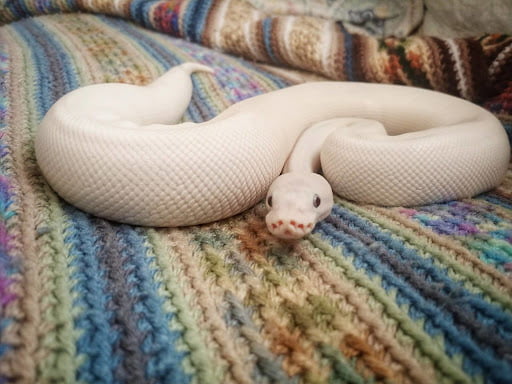
When it comes to the world of non-venomous snakes, the ball python is definitely one of the friendliest and most docile species which makes it an ideal pet for first-time snake keepers.
The ball python, or Python regius, is of the smaller varieties of snake constrictors that can be kept as pets and it is known for rolling into a tight ball with its head tucked inside its coil whenever it feels threatened, hence its name.
Ball pythons typically grow up to 4 to 6 feet and are known to live for a long time, up to 50 years maximum but most commonly around 20 to 30 years with proper care.
Contents
The Costs of Owning a Ball Python
This article will not just be focusing on the cost of buying a ball python but will also tackle the overall costs of ownership and maintenance including food, medical service and license costs.
Furthermore, one-time expenses will also be in discussion including an appropriate tank to serve as shelter for the ball python as well as various other accessories. And finally, we will look at just how much is a ball python worth during the last part of the article.
One-Time Expenses for Having a Ball Python
Since ball pythons are among the most commonly bred snakes, there are countless of morphs for you to choose from. However, ball python pricing depends on the rarity of its morph.
The cheapest price for ball pythons would be at $25, if you’re lucky. But common ball python morphs are priced at $50 and the rarer the morph, the more expensive it becomes. On the other hand, XYZ Reptiles in Florida sells theirs at $39 to $199.
Getting an albino ball python costs much more than the average and some ball pythons are worth tens of thousands. Right now, the most expensive ball python is recorded at $40,000 for a Lavender Albino Ball python, according to Financeonline.com.
Regardless of the rarity of a ball python’s morph, you are bound to find one that would catch your eye and fit your budget at the same time.
PetSmart.com offers $59.99 for the regular ball python while you can find a variety of rare morphs at SnakesAtSunset.com with prices starting from $29.99.
Aside from the actual cost of a ball python, there are other expenses that you should be ready for when you buy the snake.
- Transport Costs
If you are going to transport your new ball python home, you would need to make sure that everyone, not just the snake, would be safe during the process. You can do this by placing the snake in a reptile transport box which usually costs around $3 and securing it in a snake transport bag which you can get for $6.99.
- License and Permits
Make sure that before you buy your ball python you have already taken the time to learn all about the snake ownership regulations in your area. While most states allow ball python ownership without a license, it would be best to conduct your own research regarding licensing and permits in your home state in order to avoid confiscation of your pet snake. License and permits typically cost around $50 at best.

Things Included When Buying a Ball Python
The items included when you purchase a ball python would have to depend on the pet store or the breeder you choose to buy your snake from. Some providers would offer free frozen food for the snake or if you’re lucky, even basic necessities such as a small terrarium or items used for transport.
There are pet stores that offer free veterinary assistance for the ball python which would typically last for a few weeks until the snake has finally settled in.
But when you do buy a ball python, you should never forget to take your snake’s papers because they contain important information which would include the snake’s genetics, species, morphology, and history. These papers are important because they help you determine how many people have previously owned your snake, where it was bred, and information regarding the parents of the ball python.
Recurring Costs of Owning a Ball Python
- Enclosure Cost
Your ball python would need its very own terrarium. A baby ball python would need at least a 20-gallon tank while a 40-gallon tank is necessary for an adult. If you plan on buying a baby ball python, called juveniles, you would need to change its enclosure at least four times during the snake’s lifetime in order to accommodate its growth. Great quality tanks typically cost $100 at the very least. Females grow up to 4 to 6 feet while males are relatively smaller
Heating is also important for a ball python since it is cold blooded and cannot produce its own heat. You must see to it that the snake is provided with the warmth that it needs. You can do this by buying an under tank heater which costs around $25, a heat lamp setup usually priced at around $50 to $70, or both.
Substrates serve as the snake’s bedding and while the use of newspaper cut-outs is acceptable (and more cost-effective), it is recommended that you use at the very least Astroturf or cypress mulch or coconut. Quality substrates can cost around $10 to $25 but you can also just recycle newspaper and paper towels if you want to save on money.
Other items for your pet snake’s enclosure would include water bowls, hides, fake foliage, a soaking tub and climbing branches which at the very least costs about $25.
- Food Cost
Ball pythons could either eat frozen food like mice or live ones depending on what they are used to. Nevertheless, feeding your pet ball python would cost you about $1 or $2 depending on the size of the food. Smaller mice are ideal for juveniles but adults would need bigger food (those priced at $2 and above.
Juvenile ball pythons can eat mice or rats from a young age. However, you should make sure that the sizes of the food they eat are no bigger than the snake at its largest circumference. Ideally, feeding should be done twice a week or at least every 5 to 7 days. In the case your ball python enters a hunger strike (which usually happens when handled improperly or during shedding and winter), offer it food 10 to 14 days until it starts eating properly again.
Food doesn’t actually cost that much. Feeding a juvenile ball python would only cost you $2 if you feed it twice a week and $4 for adult ones. If you live in a rural area where mice and rats are common, you can even catch your ball python’s food on your own. However, the best place to buy ball python food is from a pet store.
You can generally choose from frozen food for the ball python or live ones.
- Medical Cost
The moment you buy your ball python, you should immediately take it to a veterinarian to see whether it has any illnesses or parasites. If the pet store you bought your snake from offers a veterinary program, then, you should take advantage of this before it expires.
Since snakes are more exotic than other pets, you can expect vets to charge more than that of a regular cat or dog. Constant check-ups are also necessary and it is your responsibility as the owner to see to it that your pet snake is in healthy condition. An initial visit to the vet might cost you around $40 and some $20 for a fecal test.
- Other Costs
You should always be prepared for emergencies. It would not hurt if you stash a bit of money in the case that your pet snake falls ill or when its cage gets broken, or the worst case scenario where it bites someone. Setting aside at least $800 for your pet snake will greatly help you during times of need.
Furthermore, if the snake you bought is really expensive, beyond $1000, it is recommended that you have it insured in order to keep you from shouldering any burden by yourself in the case something bad happens.
Cleaning your pet snake and its enclosure would also cost you. Take into account that ball pythons have long lifespans which means that you would also be dealing with the cost of maintenance as long as your pet lives.
Cost Drivers of Ball Pythons
As mentioned above, a ball python’s morph has a great effect on its price. The rarer the morph, the more expensive the snake gets.
However, other factors that may affect the price of a ball python would have to be the manner on which it is bought. Buyers could either import a ball python abroad or purchase it from a local pet store or breeder.
Buying locally would definitely save a lot more time and money. Not only that, it’s also safer to buy a ball python locally since you would be able to ask the seller important information regarding the snake directly and when problems arise, you know who you need to call.
Importing, however, can secure you rarer breeds of ball pythons.
Ball Python Buyer’s Guide
When choosing a snake, health should be an important factor to consider. The snake you choose must be at optimum health.
The ball python should have a well-rounded body with a little bit of its spine showing. This means the snake is at a desirable body weight which isn’t too thin or too fat. The ball python should be free from respiratory illnesses which you can spot when a snake is wheezing or when it has bubbles forming on its nostrils. Its eyes should be clear except when it is shedding.
Furthermore, a healthy snake is often active, alert and has good eating behavior.
Stay away from snakes that are infested with mites and ticks as they can easily spread to other animals in your household. Mite and tick infestation, when left untreated, can have dire effects on a snake’s health.
